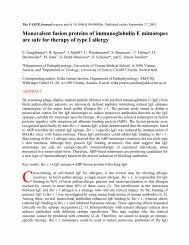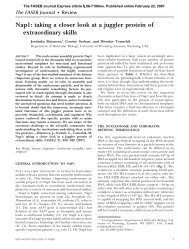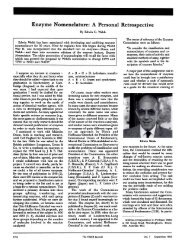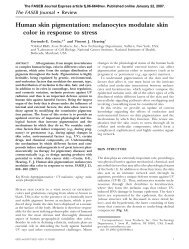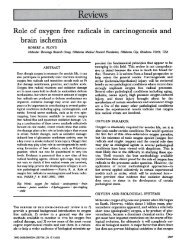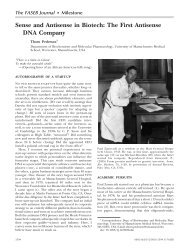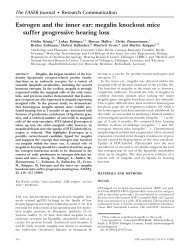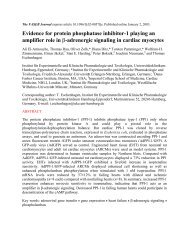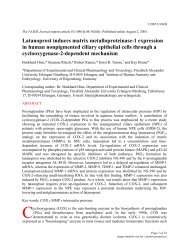(HSL) is also a retinyl ester hydrolase: evidence from mice lacking ...
(HSL) is also a retinyl ester hydrolase: evidence from mice lacking ...
(HSL) is also a retinyl ester hydrolase: evidence from mice lacking ...
Create successful ePaper yourself
Turn your PDF publications into a flip-book with our unique Google optimized e-Paper software.
Figure 1. <strong>HSL</strong> exhibits high REH activity. Homogenous<br />
preparations of recombinant rat (A) and human (B) <strong>HSL</strong><br />
were assayed against TO, MOME (a diolein analog), CO, and<br />
RP, and the activity against these substrates was compared<br />
under V max conditions (n�3–5). Values are means � se.<br />
activity against RP, although diacylglycerols were the<br />
preferred substrate for the human enzyme.<br />
REH activity <strong>is</strong> reduced in WAT and BAT of <strong>HSL</strong>-null<br />
<strong>mice</strong><br />
Recently, it was reported that REH activity <strong>is</strong> dramatically<br />
reduced in periovarial WAT of <strong>HSL</strong>-null <strong>mice</strong><br />
compared to wild-type (WT) littermates fed either<br />
control or HFD (24). Here, these analyses were extended<br />
to include both v<strong>is</strong>ceral and subcutaneous<br />
WAT, as well as BAT. As shown in Fig. 2, REH activity<br />
was dramatically decreased in all these depots of <strong>HSL</strong>null<br />
<strong>mice</strong>, suggesting that <strong>HSL</strong> <strong>is</strong> the major REH in<br />
adipose t<strong>is</strong>sue. The largest decrease in activity was seen<br />
in v<strong>is</strong>ceral WAT <strong>from</strong> <strong>HSL</strong>-null <strong>mice</strong>, exhibiting only<br />
1% of remaining activity against RP compared to WT<br />
littermates.<br />
ROH metabol<strong>is</strong>m in WAT <strong>is</strong> perturbed in <strong>HSL</strong>-null<br />
<strong>mice</strong><br />
To investigate ROH metabol<strong>is</strong>m in <strong>HSL</strong>-null <strong>mice</strong>,<br />
retinoid metabolites were measured. Regarding RA<br />
metabolites, the methodology employed allowed confident<br />
quantification of atRA and 13-c<strong>is</strong> RA in WAT,<br />
whereas the levels of 9-c<strong>is</strong> RA were too low to allow<br />
confident determination in all samples (Supplemental<br />
Fig. 1). In line with the reduced REH activity (ref. 24<br />
and Fig. 2), a marked increase in RE content and a<br />
decrease in ROH, RALD, atRA, and 13-c<strong>is</strong> RA levels<br />
were observed in perigonadal WAT <strong>from</strong> <strong>HSL</strong>-null <strong>mice</strong><br />
fed an HFD (Fig. 3A–D). No differences in plasma RA<br />
or ROH concentration were observed between <strong>HSL</strong>null<br />
<strong>mice</strong> and WT littermates in either feeding category<br />
(data not shown). To investigate the enzymes involved<br />
in the conversion of ROH to RA, we measured the<br />
expression of two members of the family of enzymes<br />
catalyzing the oxidation of ROH to RALD, i.e., Adh1<br />
and Adh3, as well as the expression of Raldh1 and<br />
Raldh2, which catalyze the terminal step of RA biosynthes<strong>is</strong>.<br />
The mRNA levels of Adh1 and Adh3 were<br />
down-regulated by 40 and 44%, respectively (Fig. 4A).<br />
Also, the mRNA level of Raldh1 was decreased by 62%,<br />
whereas Raldh2 was increased 2.6-fold in <strong>HSL</strong>-null <strong>mice</strong><br />
compared to WT littermates (Fig. 4B). Next, we investigated<br />
the mRNA levels of genes known to be transcriptionally<br />
regulated by RA (28). In agreement with<br />
the lowered RA level in WAT <strong>from</strong> <strong>HSL</strong>-null <strong>mice</strong>,<br />
decreased mRNA levels of RIP140, RBP4, S14, and<br />
SREPB1c (Fig. 4C), as well as RAR� (Fig. 4D), were<br />
found in <strong>HSL</strong>-null <strong>mice</strong> compared to WT littermates. A<br />
reduction of RAR� protein by 60% in WAT of <strong>HSL</strong>-null<br />
<strong>mice</strong> was confirmed using W<strong>ester</strong>n blot analys<strong>is</strong> (Fig.<br />
4E). Also, the mRNA level of RXR� was decreased in<br />
WAT of <strong>HSL</strong>-null <strong>mice</strong> compared to WT littermates<br />
(Fig. 4D).<br />
Dietary admin<strong>is</strong>tration of RA rescues the WAT and<br />
BAT phenotype of <strong>HSL</strong>-null <strong>mice</strong><br />
<strong>HSL</strong>-null <strong>mice</strong> are res<strong>is</strong>tant to diet-induced obesity,<br />
which <strong>is</strong> accompanied by impaired adipogenes<strong>is</strong> (18,<br />
19) and attainment of brown adipocyte features of<br />
WAT (18). Having establ<strong>is</strong>hed that retinoid metabol<strong>is</strong>m<br />
<strong>is</strong> perturbed in WAT of <strong>HSL</strong>-null <strong>mice</strong>, we investigated<br />
to what extent th<strong>is</strong> contributes to the adipose t<strong>is</strong>sue<br />
Figure 2. REH activity <strong>is</strong> reduced in WAT and BAT of<br />
<strong>HSL</strong>-null <strong>mice</strong>. REH activity was determined in v<strong>is</strong>ceral (epididymal;<br />
eWAT) and subcutaneous (inguinal; iWAT) WAT as<br />
well as BAT (interscapular; iBAT) <strong>from</strong> 6-mo-old male <strong>mice</strong><br />
fed a normal chow diet (n�4). Values are means � se; *P �<br />
0.05; 1-way ANOVA with by Bonferroni’s multiple compar<strong>is</strong>on<br />
test.<br />
2310 Vol. 23 July 2009 The FASEB Journal<br />
STRÖM ET AL.



